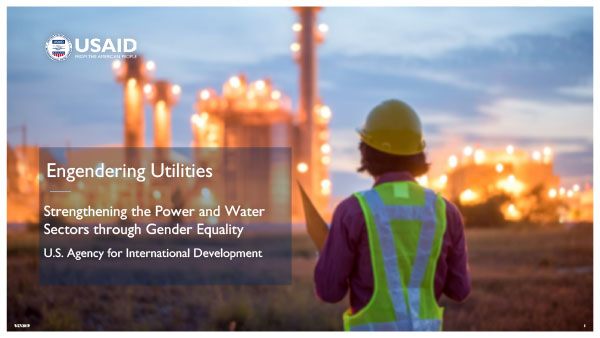- Energy Home
- How We Work
- Programs & Initiatives
- EmPOWERing Women and Girls
- Competitive Energy Procurement
- Toolkits
- Monitoring & Evaluation
- Resources
- Stories
Speeches Shim
Engendering Utilities works with electricity and water utilities in developing countries to increase economic opportunities for women and improve gender equality in the workplace. This presentation provides a brief overview of the program, its activities and results.
USAID began the Engendering Utilities program by conducting baseline research across 14 electric utilities globally to analyze the role of women in the power sector. Next, tailored interventions were developed with seven utilities to enhance gender equity in each utility’s policies and operations. Then, tools and an executive leadership program were developed focusing on global gender best practices throughout the employee life cycle model. Today, USAID continues to expand the approach, partnering with electric and water utilities globally, while continuing to provide tailored coaching to its graduated partners.
Conducting Groundbreaking Research on Gender Disparity in the Energy Sector
The Engendering Utilities program began with a study—the first of its kind—to examine the role of women and gender disparities within electric power distribution companies. The data showed wide variation in employment practices and outcomes and suggested that women were excluded from the majority of jobs within these companies. The findings illustrated inequalities in employment outcomes and disparities in the way utilities run their businesses, both of which ultimately impact women’s ability to fully participate in the energy sector.
Partnering with Utilities to Increase Gender Equality, Create Leadership Opportunities and Develop Talent
To address the research findings, USAID’s Engendering Utilities program began working with an initial cohort of seven electricity utilities in 2016 to improve gender equality outcomes and enhance business performance. Over the past three years, USAID has partnered with 17 utilities from 14 countries to implement tailored interventions to improve gender equality outcomes, guided by an evidence-based approach that includes global best practices, a Gender Equity Executive Leadership Program, and tailored change management coaching.
As a result of the interventions implemented so far, all of the first cohort of graduated utilities saw an increase in the number of female employees. Most utilities also saw an increase in the number of women participating in employee training programs, and some saw an increase in the number of women trainees hired, the number of women interviewed, and the number of women participating in internship programs. Additionally, all of the partner utilities have reviewed their human resources procedures and benefits against a global standard and are in the process of adopting equal opportunity statements. They have also conducted salary reviews to examine gender gaps in pay and are collecting sex-disaggregated employee satisfaction data, many for the first time in the company’s history.
Reforming the Employee Life Cycle to Solidify Long-term Organizational Change
In 2017, USAID refined the approach of the Engendering Utilities program to focus specifically on improving gender equity throughout the employee life cycle. From hiring and recruitment to retirement and succession planning, interventions along the employee life cycle represent significant opportunities to promote gender equality within the utilities.
The Engendering Utilities Human Resources Framework
USAID developed this compilation of global best practices as a tool to increase gender equity throughout the employee life cycle—helping utilities benchmark their current policies, practices, and operations against global best practices.
Gender Equity Executive Leadership Program
Developed by USAID and Georgetown University, partner utilities receive training to design and implement activities to address identified gender equality gaps. The course builds the capacity of key human resources administrators, operational area managers, and other key decision-makers in the partner utilities to effectively integrate gender equity initiatives within their corporate structure.
Expert Coaching
USAID pairs each utility partner with a dedicated expert change management coach with gender equality expertise who provides tailored technical support to partner utilities as they analyze gaps, design and implement interventions, and monitor their progress toward gender equality and strengthening business outcomes.
Implementation of Gender Equity Interventions
Each partner utility conducts analysis to understand key gender equality gaps and designs and implements appropriate interventions throughout their participation in the program, drawing upon the program’s Best Practices Framework.
Robust Monitoring and Evaluation
Baseline assessments aligned with the program’s employee life cycle model allow utilities to benchmark themselves, understand their strengths and weaknesses, and track their progress in close collaboration with their dedicated change management coach. The robust data collection and analysis add to the global evidence base to support understanding of the most effective interventions for utilities to improve gender equality and business performance.


Comment
Make a general inquiry or suggest an improvement.